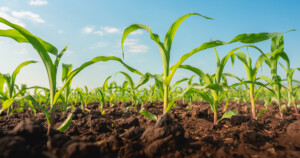“Life.” That was my response when asked “What does soil health mean?” during an interview on The Big Show with WHO Radio last week. Whether it’s accelerating populations of soil microbes and worms, creating diverse biological communities or building biomass and aggregates, healthy soils are full of life. The trick is to stimulate and maintain biology in the soil year-round. Huma products play a key role in fostering and accelerating life in the soil.
Does your farm run on ancient sunlight or current sunlight? That was a question posed by keynote speaker Ray Archuleta (noted regen ag advocate who starred in the film Kiss the Ground) at last week’s Big Soil Health event. The premise is that soil health is built on organic matter formed from nature and nature-friendly practices, including the use of humates, while current sunlight speaks to a reliance on short-sighted production practices and synthetic crop inputs. Interestingly, the rollout of the Huma brand launch featured the headline “Harness the Power of Ancient Sunlight.”

Two prevailing themes emerged from content presented at last week’s Big Soil Health event. First was the circular concept of microbes helping feed crops, delivering nutrients to crop roots; while crop root exudes help feed the microbes. This is not necessarily a new concept, but a growing amount of management, research and attention is being devoted to the approach. What surprisingly garnered much of the discussion was the incorporation of livestock into cropping systems. Long regarded as a regenerative ag practice, it’s often overlooked due to logistical issues. Yet many feel rotational grazing nets 2x the benefits of all other soil health practices combined. Moving grazing cattle, often on a daily basis, is a highly effective, yet complicated and labor-intensive practice. But now, as the popular saying goes, there’s an app for that. The use of glorified shock collars, similar to those used on dogs, is creating virtual fencing that can be moved using cell phone technology. While the technology is not widespread, it is showing interesting potential.
A new world corn yield record was announced last week, but the current record-holder isn’t too upset. That’s because David Hula broke his own record once again, yielding an astonishing 623 bushels per acre, topping his previous mark by eight bushels. He placed his entry in the strip-till irrigated category. This marks the third time that the Charles City, Virginia, farmer has topped the 600-bushel mark.
Next Monday we celebrate the greatest farm venue in history: a manger in a Bethlehem stable. Merry Christmas!
Related Posts

This Week in Ag #38
When you’re carving your Halloween pumpkins this week, be sure to thank a bee. That’s because pumpkins are not self-pollinating plants. Unlike cotton and soybeans, where pollen produced within a flower fertilizes the ovary of the same flower on the same plant, pumpkins have specific male and female flowers across their vines. So they need bees to carry pollen between the flowers. Pumpkin growers will rent bee colonies during the growing season to ensure better pollination and higher yields.

This Week in Ag #5
It’s Commodity Classic week. This is one of the ag industry’s most important shows, and among my favorite times of the year. I’ll be in Orlando for the show, as will Lyndon Smith, Barrett Smith and Michael Gardner. #Classic23 is expected to draw around 5,000 farmers. But what makes this show exceptional is not the number

This Week in Ag #10
Football may be a game of inches, but farming is a business of fractional inches. Take planting. Seed placement is paramount to the success of a crop. Farmers spend lots of time calculating the optimum rate and depth to plant their seeds based on genetics, soil type, soil conditions, weather, management practices and the desired output

